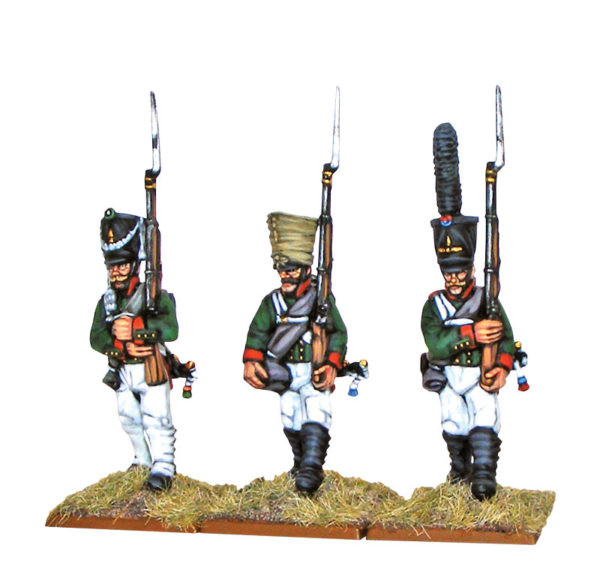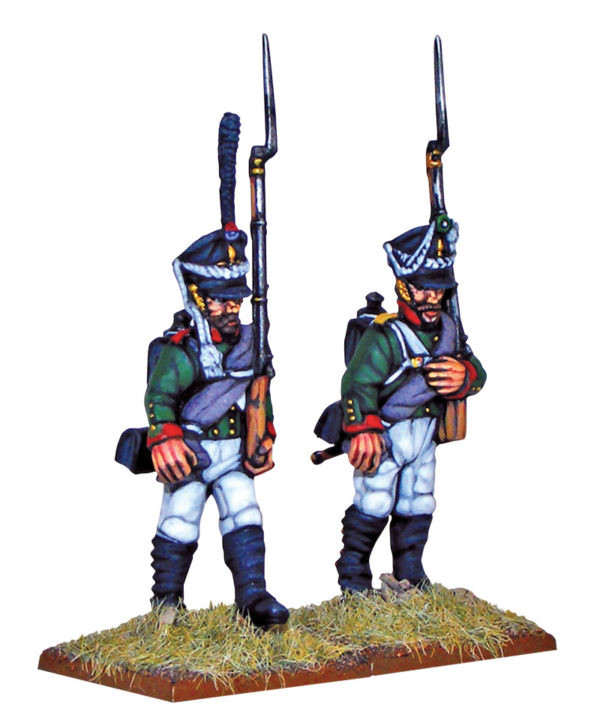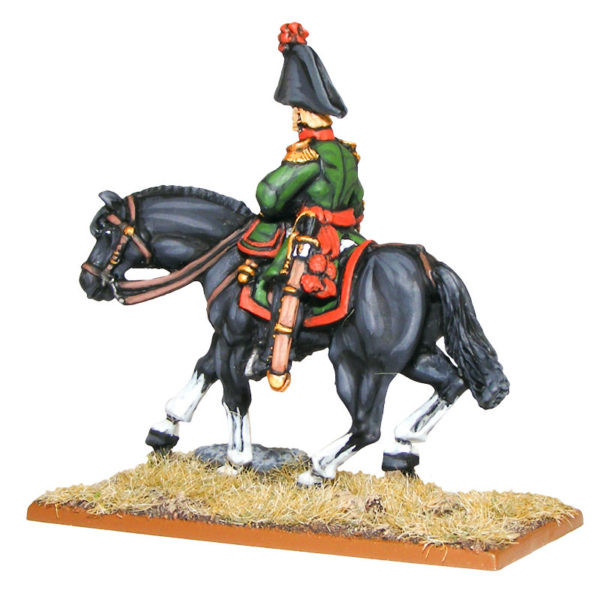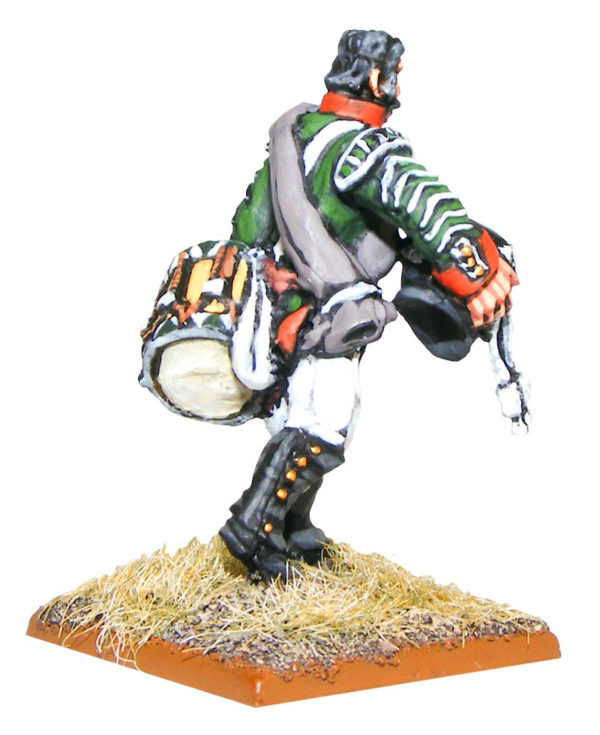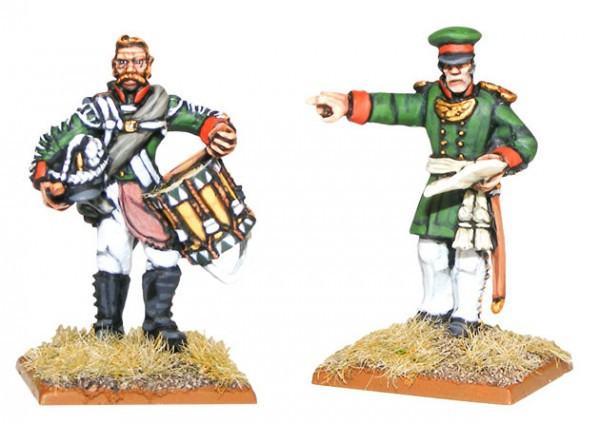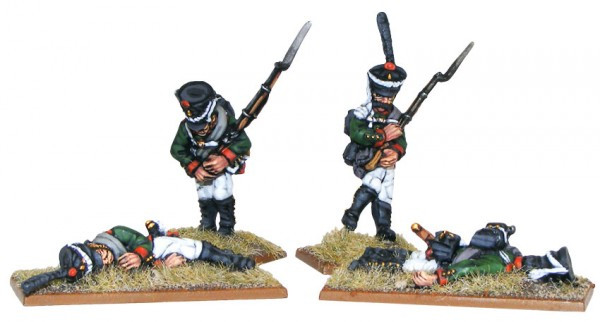The uniforms of the Russian army during the Napoleonic Wars (roughly 1808-1815) are a fascinating subject for military history enthusiasts. Dominated by a distinctive dark green jacket and white trousers combination, the Russian infantryman presented a unique appearance on the battlefields of Europe. While seemingly simple at first glance, the uniforms were rich in detail and evolved throughout the period, reflecting changes in regulations and practical battlefield needs. Let’s delve into the specifics of these iconic military garments.
A depiction of Russian infantry soldiers in their dark green uniforms and white trousers, characteristic of the Napoleonic Wars era.
The core of the Russian infantry uniform was the dark green jacket. The precise shade of this green is often debated by historians and uniform enthusiasts. Descriptions range from “olive green,” reminiscent of the hues illustrated by Knötel, a renowned uniform plate artist, to “bottle green,” suggesting a deeper, richer tone. It’s likely that the dye lots varied, resulting in a spectrum of dark greens across the vast Russian army, but a consistently dark green was undoubtedly the intended standard.
By 1807, a standardized scheme of regimental colors was implemented. All infantry regiments adopted red for their collars, cuffs, and turnbacks (the inner linings of the jacket tails). Shoulder straps served as a crucial identifier, indicating a regiment’s seniority within its division. The Russian army’s organization was relatively stable during this period, making the pre-1811 and 1812-1814 periods key for researchers studying uniform variations. The color sequence for shoulder straps was based on regimental number: 1st Regiment – red, 2nd Regiment – white, 3rd Regiment – yellow, 4th Regiment – dark green piped red, and 5th Regiment – light blue. Furthermore, the division number was often embroidered onto the shoulder strap for added identification.
Russian soldiers in winter uniform, showcasing the greatcoat over their standard dark green jackets and white trousers, highlighting the practical adaptations for campaigning in colder climates.
The infantry jacket featured six brass buttons down the front lapels, three on each cuff flap, and a single button securing the shoulder strap. White leather was standard for belts and other leather accoutrements. The sword hanger was made of black leather, reinforced with brass bindings and fittings. A white sword strap was worn, though the specific design of the bell and fringe varied depending on the period. For inclement weather and campaigns, soldiers were issued a brown-grey greatcoat, which was typically carried rolled on the knapsack or worn over the shoulders. Knapsacks were constructed from either black leather or durable canvas.
An officer of the early Russian Napoleonic army, distinguished by gold epaulettes and a white sash, illustrating the visual differences in officer attire compared to enlisted ranks.
The shako, a tall, cylindrical hat, was crafted from black felt and reinforced with leather bands at the top, bottom, and sides, along with a front visor. A brass grenade insignia was centrally placed on the shako front. For musketeers, the grenade depicted a flame extending upwards, while grenadiers’ grenades showed flames projecting from the sides as well. Up to 1809, some shakos included a black cockade, edged with orange and secured by a brass button.
A Russian drummer in distinctive uniform, potentially showcasing variations in color or trim to denote their non-combatant role within the infantry regiment.
After 1809, the cockade began to disappear from shakos, replaced by a pompom at the shako’s crown. Before 1810, this pompom indicated battalion and regimental colors: the battalion color dominated, with the regimental color as a central detail. Battalion colors were: 1st Battalion – white, 2nd Battalion – yellow, and 3rd Battalion – red. The regimental color formed the base or “turf” of the pompom. Post-1810, the pompom color system became more intricate, differentiating between Grenadiers, Chasseurs, and Musketeers battalions as shown in the table below:
| Battalion | Grenadiers | Chasseurs | Musketeers |
|---|---|---|---|
| I | Red | Yellow | White/Green Center |
| II | Red over Green | Yellow over Green | Green /White Center |
| III | Red over Lt. Blue | Yellow over Lt. Blue | L. Blue over White |
Further unit distinctions were conveyed through sword straps and knots. While the strap and fringe remained white, the ball (knot) at the end varied:
| Battalion | Grenadiers | Chasseurs | Musketeers Companies |
|---|---|---|---|
| I | Red | Yellow | 1-White, 2-White/Blue, 3-White/Orange |
| II | Red/Green | Yellow/Green | 1-Green/White, 2-Green/Blue, 3-Green/Orange |
| III | Red/Lt Blue | Yellow/Lt Blue | 1-Lt. Blue/White, 2-Lt. Blue/Blue, 3-Lt. Blue/Orange |
In 1811, greatcoats were updated with colored cuffs that corresponded to the regimental color within the division. For example, consider this divisional color scheme:
| 1807 – 1811 | 1812 – 1814 |
|————-|————-|————-|————-|
| Regiment | Division | Colour | Division | Colour |
| Ladoga | 13 | Yellow | 26 | White |
| Libau | 21 | Green | 7 | Yellow |
| Lithuania | 1 | Blue | 21 | Yellow |
Marine regiments, of which there were four, sported dark green facings piped in white. In 1812, their shoulder strap colors were codified: 25th Regiment – White, 26th Regiment – Yellow, 27th Regiment – Green, and 28th Regiment – Red.
Jaegers (light infantry) regiments maintained the same uniform style, but in a lighter shade of green. Their collar, cuffs, and lapels were also light green, piped red. Shoulder straps followed the divisional color scheme; for instance, the second regiment used pink. Pompoms were colored with the center in the divisional color, and battalion colors mirrored the line infantry: 1st Battalion – white, 2nd Battalion – yellow, and 3rd Battalion – red.
Russian command figures, likely officers and standard bearers, demonstrating the more elaborate uniforms of command personnel within the Napoleonic Russian army.
Non-Commissioned Officers (NCOs) were distinguished by gold lace on the cuffs (front/lower edges), collar (front/upper edges), and shako (top edge). Officers’ uniforms were further embellished with gold epaulettes and a white sash interwoven with orange and black stripes.
A poignant depiction of casualties, likely intended to illustrate the human cost of the Napoleonic Wars, and incidentally showing details of the Russian uniforms in a battlefield context.
Russian infantry flags evolved across two key periods: 1803 and 1813. The 1803 pattern stipulated each regiment carrying one “white” flag and one “colored” flag per battalion, each measuring 140cm square. The flag’s center featured a gold laurel wreath tied with a light blue ribbon, enclosing a black two-headed Russian Imperial Eagle with gold crowns and lightning bolts. A gold crown topped the wreath. Borders emanating from the corners formed a Maltese cross on each side. The corners displayed the imperial cypher within a laurel wreath, surmounted by a crown, all in gold.
In the “white” flag, the field was white, with corner colors corresponding to the inspectorate. Inspectorate colors were regionally based:
| Inspection | Background |
|---|---|
| Brest-Litevski | Deep Yellow |
| Dniester | Lilac |
| Caucasus | Blue |
| Crimea | Light Brown |
| Finland | Yellow |
| Kiev | Deep Pink |
| Lithuania | Pale Green |
| Livonia | Turquoise |
| Moscow | Orange |
| St. Petersburg | Black |
| Orenburg | Bluff |
| Siberia | Grey |
| Smolensk | White |
| Ukraine | Pale Pink |
For the “colored” flag, the background adopted the inspectorate color, with white corners. However, according to historian Keith Over, the inspectorate system for flags was discontinued after 1807, and subsequent flag systems did not utilize it.
After 1813, all newly issued line infantry flags were standardized to a green field with white corners. For further research into Russian flags of this era, the website Warflag.com is an invaluable resource.
References:
Haythornthwaite, Philip. The Russian Army of the Napoleonic Wars (I) Infantry 1799 – 1814. Osprey: London, 1987
Knötel, Herbert & Col. John R. Elting. Napoleonic Uniforms Vol IV. Emperor’s Press: Rosemont, 2000
Nafzinger, George. The Imperial Russian Army (1763 – 1815) Volume I. Nafzinger: Pisgah, Ohio, 1996
Over, Keith. Flags and Standards of the Napoleonic Wars. Bivouac Books: London 1976.

